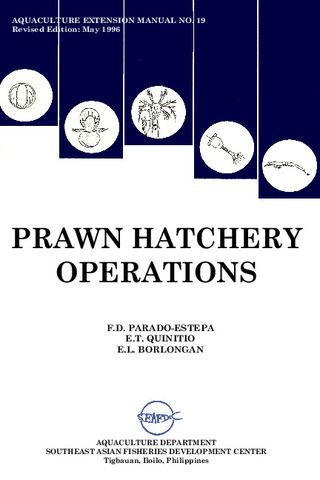Development of farming schemes following disease occurrences in monodon shrimp farming using intensive method in three Southeast Asian countries
- Global styles
- MLA
- Vancouver
- Elsevier - Harvard
- APA
- Help

閲覧/開く
日付
2007Page views
1,891ASFA keyword
AGROVOC keyword
Taxonomic term
Metadata
アイテムの詳細レコードを表示する
Share
抄録
All three countries experienced major progress in intensive shrimp farming at different ties. Intensive farming of monodon shrimp (Penaeus monodon, an indigenous species) was first launched by the Philippines, followed by Thailand, then by Peninsular Malaysia. The survey was conducted from 2000-2005. The disease-causing bacterial that seiously damaged monodon culture were luminous bacteria in the Philippines and white spot virus in Thailand and Malaysia. Production decreased because of these diseases in the mid-1990s in the Philippines and after 2000 in Thailand and Malaysia. In 1998, the Green Water System (hereinafter referred to as GWS) was developed, and a proportion of culture ponds introduced it and resumed monodon culture using the intensive method. In Thailand, the vannamei shrimp (Penaeus vannamei, an exotic species from South America) has now replaced monodon previously raised using the extensive method. In Malaysia, monodon is cultured using only the intensive method, and some culture pond enterprises started to culture vannamei instead of monodon in 2004. In the Philippines, companies engaging in monodon culture have many ponds and lower stocking density because they culture large-size shrimp, but are exposed to high running costs such as fuels and probiotics. On the other hand, in Thailand, individuals engaging in monodon culture have few ponds and higher stocking density since they culture small-scale shrimp. Labor costs are low because most of the work is done by family member.
記述
Also In K. Nakamura (Ed.), Sustainable Production Systems of Aquatic Animals in Brackish Mangrove Areas (JIRCAS Working Report No. 56) (pp. 127-134). Tsukuba, Ibaraki, Japan: Japan International Research Center for Agricultural Sciences
Suggested Citation
Matsuura, T., de la Peña, L. D., Ean, C. P., Siow, R., & Alias, A. H. (2007). Development of farming schemes following disease occurrences in monodon shrimp farming using intensive method in three Southeast Asian countries. In T. Matsuura (Ed.), Sustainable Production Systems of Aquatic Animals in Brackish Mangrove Areas (JIRCAS Working Report No. 56) (pp. 43-52). Tsukuba, Ibaraki, Japan: Japan International Research Center for Agricultural Sciences
Type
Book chapterISSN
1341-710Xシリーズ
JIRCAS Working Report; No. 56Collections
- Books and Book Chapters [120]
Related items
Showing items related by title, author, creator and subject.
-
An overview of the nutrition, feed and feeding techniques of prawn penaeid/shrimps
Piedad-Pascual, Felicitas (Philippine Council for Aquatic and Marine Research and Development, 1989)This paper echoes what transpired during the first International Conference of Penaeid Prawns/Shrimps held in Iloilo City in December 4-7, 1984, particularly on the Nutrition nd Feed Development. Around 25 papers were ... -
Series: Aquaculture extension manual; No. 19
Prawn hatchery operations
Parado-Estepa, Fe D.; Quinitio, Emilia T. ; Borlongan, Emeterio L. (Aquaculture Department, Southeast Asian Fisheries Development Center, 1996-05)
The manual, an updated version of the 1984 SEAFDEC/AQD manual, presents the underlying principles and step-by-step instructions of prawn larval and post-larval rearing. The techniques described are not only applicable to ...
; Borlongan, Emeterio L. (Aquaculture Department, Southeast Asian Fisheries Development Center, 1996-05)
The manual, an updated version of the 1984 SEAFDEC/AQD manual, presents the underlying principles and step-by-step instructions of prawn larval and post-larval rearing. The techniques described are not only applicable to ... -
The lowdown on world shrimp culture - II
Yap, Wilfredo G. (INFOFISH, 2001)This paper introduces some new members of the international shrimp culture club and goes on to discuss some recent technological innovations in the industry, particularly the polyculture of tilapia (mainly Oreochromis ...





